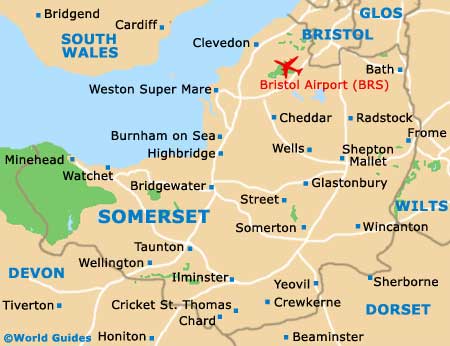Somerset
Information and Tourism

Somerset covers a vast area of land in the south-west of
England, from the rolling Blackdown Hills on the Somerset-Devon border, to the Mendips and Quantocks south of
Bristol, and finishing in the west with the Exmoor National Park. To the north is Bath and North-East Somerset, which although administered separately, nonetheless feel like part and parcel of this English county.
There is a stereotype that Somerset is full of cider-drinking, Cheddar cheese-eating country yokels that bear more than a passing resemblance to that well-known band 'The Wurzels'. It is true that the county's apple orchards once played a major role in life here. Today, cider holds less of a sway in the county, but a few orchards and cider producers do remain. Cheddar cheese is still very much a Somerset speciality.
Less well-known than cheese and cider is the local traditional willow weaving industry. Willow is still grown in quantity on the Somerset Levels, a flat area of wetland that once lay under a brackish sea for all but the summer months.
Underneath Somerset is a complicated network of caves and underground rivers that emerge above the surface in Cheddar Gorge and at nearby Wookey Hole. Both attractions, with their fascinating and weird stalagmites and stalactites, draw thousands of visitors each year.
Many people pay a visit to the small town of Glastonbury, or rather to a series of farm fields nearby. The Glastonbury Festival of Contemporary Performing Arts, to give it its full title, has been staged since the 1970s, when it had a distinctly hippy feel. Today, this world-famous pop festival is far bigger in size and struggles to cope with the vagaries of commercialisation and the English weather. Pictures of mud-covered festival-goers aren't uncommon. Glastonbury itself is a seemingly ordinary Somerset town, but it is actually home to a vibrant New Age community.
In the north of Somerset, Bath is an altogether more genteel affair. Its grand Georgian architecture, Jane Austen literary connections and rich Roman heritage quite rightly exert a powerful pull on visiting coach parties. Just under 30 minutes away from Bath, the quaint market town of Frome is known for its high concentration of listed buildings, which in fact number more than any of the county's other towns.
Somerset Information and Fast Facts
- Country: England
- Region: South-West England
- Population: approximately 925,000
- County administrative town or city: Taunton
- Biggest city: Bath
- Language: English
- Area: 1,610 square miles / 4,170 square kilometres
- Highest point (Dunkery Beacon, Exmoor): 1,706 feet / 520 metres
|
WORLD GUIDES TO SOMERSET |
 |
World Guide to Bath, England
Bath serves as one of the most attractive, elegant and historic cities in England, brimming with imposing architecture and lengthy Georgian streets. Roman Bath is now classed as a World Heritage City and draws crowds of summer tourists. |
 |
World Guide to Frome, England
The market town of Frome is full of historic and was founded by St. Aldhelm in 685 AD. Frome has always been a prosperous town and gained much wealth from the wool industry in the 17th century, when Frome was larger than nearby Bath. |
 |
World Guide to Glastonbury, England
A small and surprisingly well-known Somerset town, Glastonbury is famed for is Christian connections, spiritual legends and fascinating mythology. However, is it Glastonbury's Pop Festival that draws the biggest crowds each year. |
 |
World Guide to Weston Super Mare, England
A traditional seaside town close to Bristol, Weston Super Mare is a true tourist hot spot in the summer months, although is quite deserted out of season. Weston Super Mare's beach and pier are where the main attractions are gathered. |
Map of Somerset

 Somerset covers a vast area of land in the south-west of England, from the rolling Blackdown Hills on the Somerset-Devon border, to the Mendips and Quantocks south of Bristol, and finishing in the west with the Exmoor National Park. To the north is Bath and North-East Somerset, which although administered separately, nonetheless feel like part and parcel of this English county.
Somerset covers a vast area of land in the south-west of England, from the rolling Blackdown Hills on the Somerset-Devon border, to the Mendips and Quantocks south of Bristol, and finishing in the west with the Exmoor National Park. To the north is Bath and North-East Somerset, which although administered separately, nonetheless feel like part and parcel of this English county.



